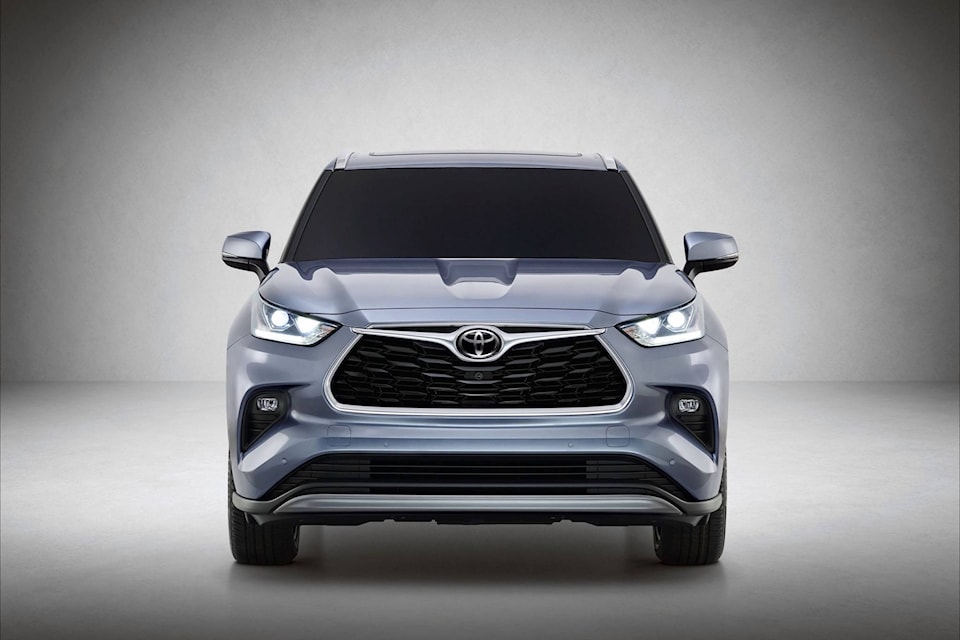Comfort, roominess and capability are the 2020 Toyota Highlander’s key strengths, as they have been for the past 18 model years.
When it arrived for 2002, the Highlander was one of the initial part-car, part-sport-utility-vehicle models on the market. By the time a third-row seat was added a couple of years later, it had become one of the most popular Toyota vehicles.
The previous Highlander’s oversized trapezoid-style grille was not its most welcoming feature, but the nosepiece of the new fourth-generation model improves on that misstep and could serve as a template for future Toyota vehicles. The remainder of the body, from the hood to the liftgate, is also more attractive and correctly conveys a sense that the Highlander is a quality machine.
That also goes for the roomier cabin. A bigger vehicle means an increase in the second-row seat’s fore and aft travel to 11 centimetres from 8.6. That means more legroom. As before, there’s space for eight passengers, or seven when the second-row bucket seats replace the standard bench seat.
The Highlander’s dashboard is more dramatically shaped with an available 12.3-inch touch-screen that juts out, right next to the luminescent gauges. An 8.0-inch screen is standard for most other trims.
Underpinning the Highlander is Toyota’s New Global Architecture that the automaker claims is stiffer and helps deliver a quieter ride plus a smaller turning circle.
Revised powertrain offerings start with a 3.5-litre V-6 that carries over from 2019 and makes 295 horsepower and 263 pound-feet of torque.
The optional hybrid model constitutes significant change for the Highlander. Replacing the previous 306-horsepower V-6/electric-motor combo is a 2.5-litre four-cylinder with two integrated electric motors for a net system output of 243 horsepower. This is far less punch than outgoing system, but Toyota says the all-wheel-drive hybrid’s estimated 6.7 l/100 km in combined city/highway driving is 19 per cent better. Gasoline Highlanders achieve an estimated 10.3 l/100 km, combined.
The hybrid’s more compact (but more energy-dense) battery pack is located beneath the rear seats so there’s no loss of stowage or passenger space.
The V-6 is linked to an eight-speed automatic transmission, while a continuously variable unit with Normal, Eco and Sport modes is standard with the hybrid models.
For 2020, three different AWD systems are available. The L , LE and XLE trims ship up to 50 per cent of the engine torque to the rear wheels when the front wheels begin to slip.
The Dynamic Torque Vectoring AWD, optional for the Limited and Platinum trims, can vary the rear torque between the left and right wheels (the torque-vectoring part) for increased control when turning. Mud & Sand and Rock & Dirt modes are part of the system, as is a Rear Driveline Disconnect feature that unhooks the driveshaft from the rear wheels when not needed, which conserves fuel.
The hybrid’s AWD uses an electric motor mounted in back. It powers the rear wheels when accelerating and while cornering, for added control.
Highlander pricing starts at $41,800, including destination charges, for the base L and includes heated front power driver’s seat and a wide assortment of active-safety features.
From that point, both content levels and prices climb steadily, topping out with the $55,800 Platinum trim, which includes self-leveling headlamps, heated second-row seats, panoramic moonroof, surround-view camera, heated and ventilated front seats, and a head-up information display for the driver.
Note that all but the base L trim can be ordered with hybrid propulsion.
The 2020 Highlander might look radically different from the outgoing model, but its advancements in useable space, technology and fuel economy are really what make this a standout utility vehicle.
What you should know: 2020 Toyota Highlander
Type: Front-/ all-wheel-drive utility vehicle
Engines (h.p.): 3.5-litre DOHC V-6 (295); 2.5-litre DOHC I-4 with electric motors (243)
Transmissions: Eight-speed automatic; continuously variable (CVT, hybrid)
Market position: The Highlander is considered one of the top-performing family utility vehicles on the market and is also viewed as one of the roomiest and most technologically advanced.
Points: Major redesign improves the looks, especially at the front end. • Standard V-6 engine delivers plenty of power, while optional hybrid system places greater emphasis on lowering fuel consumption. • Added cargo space makes for a more versatile vehicle. • Toyota’s quality reputation and strong resale values contribute to the Highlander’s popularity.
Driver assist: Blind-spot warning with cross-traffic backup alert (opt.); active cruise control (std.); emergency braking (std.); pedestrian detection (std.); lane-departure alert/intervention (std.)
L/100 km (city/hwy): 11.8/8.7 (V-6, est.); Base price (incl. destination) $41,800
BY COMPARISON
Chevrolet Traverse
Base price: $41,600
A 310-h.p. V-6 comes standard in this eight-passenger tall wagon. AWD optional.
Honda Pilot
Base price: $43,200
Eight-passenger model matches Highlander’s 2,270-kg towing capacity.
Mazda CX-9
Base price: $42,000
Sharp-looking utility vehicle inside and out. A 250-h.p. turbo I-4 comes standard.
If you’re interested in new or used vehicles, be sure to visit TodaysDrive.com to find your dream car today!
-written by Malcom Gunn, Managing Partner at Wheelbase Media
